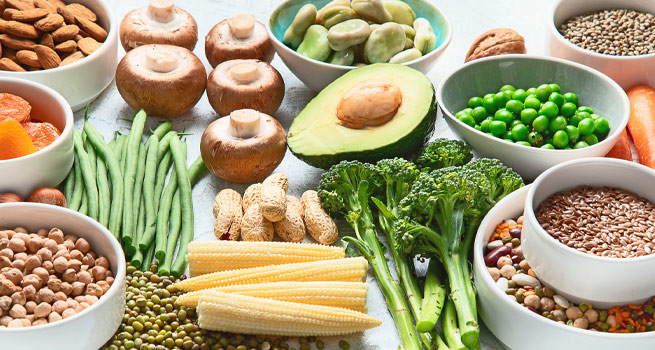
Plant Protein
Proteins are an important dietary source for the human body. They are used to build and repair tissue, and used in specific chemical reactions within the body. Protein makes up about 15% of a person’s total body weight.
Proteins are chemically composed of organic compounds called amino acids. Amino acids are the “building blocks” for the body to make protein. Each protein molecule can be composed of 23 different Amino Acids.
Fun fact: the longest known amino acid chain is found in muscle tissue and is over 30,000 amino acids long! It is called Connectin.
There are two types of amino acids: Essential and Non-Essential. The body can make some amino acids but not all of them. Essential amino acids must be included in our diet because our body cannot make these.
There are 10 essential amino acids. They are: Phenylalanine, Valine, Threonine, Tryptophan, Isoleucine, Methionine, Histidine, Arginine, Leucine, Lysine. This set of amino acids is commonly referred by its acronym Private Tim Hall (P.V.T T.I.M H.A.L.L).
A protein that supplies all 10 essential amino acids is called a complete protein. Some examples of complete protein foods are:
• Quinoa
• Buckwheat
• Soy
• Pumpkin seeds
• Chia seeds
A complimentary protein is when two or more proteins combined together yield a complete protein. Most legumes and grains (beans and rice) together form complete protein sources.
Many people have been misled to believe that large amounts of protein are required in the human diet, but this is false. In fact, as we age we need less and less protein. The most important time for us to incorporate the largest amounts of protein in our diet is during adolescence, when our bodies are developing, and during pregnancy and lactation.
Another misconception is that protein can only be obtained from animal meat, however, all protein is initially made by plants by way of photosynthesis. Photosynthesis is the process in which plants transform sunlight energy into chemical energy by the conversion of CO2 (carbon dioxide) and inorganic nutrients (those lacking carbon dioxide). During this process, a chemical element called nitrogen is extracted and broken apart into smaller molecules. These nitrogen molecules are incorporated into the amino acids within the plant. This process and union of molecules is the foundation in which all protein is made. Eating animal flesh to obtain protein is unnessasary. Furthermore, eating animals compounds an enormous amount of other potential health-destructive problems (please read Animal Protein for more information).
Fun Fact: Chlorella is an algae that grows in freshwater. It is loaded with vitamins and antioxidants. It contains the highest amount of chlorophyll which is an essential nutrient for the human diet. It is rich in amino acids and an excellent source of Iron, Vitamin B 12, Lipoic acid and minerals. An easy way to incorporate this powerhouse super-food is through liquid drops in your alkaline water!
Plant Based Protein per cup
Legumes
Soybean 28.6 grams
Kidney Beans 15.6 grams
Lentils 17.9 grams
Black Beans 15.2 grams
Peas 16.4 grams
Garbanzo Beans 14.5 grams
Pinto Beans 14.0 grams
Grains
Rye 18.3 grams
Quinoa 5.6 grams
Oats 6.1 grams
Wheat 5.6 grams
Buckwheat 5.7 grams
Brown Rice 5.0 grams
Vegetables
Spinach 5.4 grams
Collards 4.0 grams
Asparagus 4.7 grams
Swiss Chard 3.3 grams
Broccoli 4.7 grams
Nuts and Seeds (per ¼ cup)
Peanuts 9.4 grams
Cashews 5.2 grams
Pumpkin Seeds 8.5 grams
Walnuts 3.8 grams
Sunflower Seeds 8.2 grams
Almonds 7.6 grams
Protein Adequate Daily Intake by Age
0-6 months 9.1 grams
6-12 months 13.5 grams
1-3 years 13.0 grams
4-8 years 19.0 grams
Males
14-18 years 52.0 grams
19+ years 56.0 grams
Females
19+ years 46.0 grams
Pregnant/Lactating 71.0 grams
References:
The Worlds Healthiest Foods 2nd edition